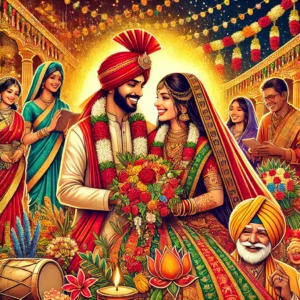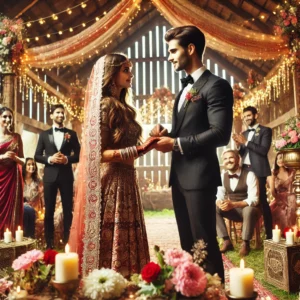Intercaste marriages are a bold declaration of love that transcend traditional societal boundaries. They symbolise progress in a world striving for equality, acceptance, and unity. Despite challenges such as societal judgment, family opposition, and cultural differences, many intercaste couples have not only survived but thrived, proving that love can indeed conquer all. Here are some inspiring stories of successful intercaste marriages that broke barriers and redefined traditions.

Story 1: From Hesitation to Harmony – Priya and Arjun
Priya, a Tamil Brahmin, and Arjun, a Punjabi Jat, met during their post-graduation in Delhi. Their love story began with heated debates in the classroom and blossomed into a deep friendship. However, when their relationship turned romantic, the challenges began. Both families were initially resistant due to their differing languages, cuisines, and customs.
“Our parents feared we would lose our cultural roots,” Priya recalls. “They were worried about how we would maintain our identities.”
Determined to gain their families’ blessings, the couple spent months introducing each other’s families to their respective cultures. Priya learned Punjabi recipes, while Arjun mastered Tamil phrases and customs. Eventually, their persistence paid off, and the families not only accepted their union but celebrated the blending of traditions during their wedding—a beautiful amalgamation of Tamil and Punjabi rituals.
Story 2: A Love Across Continents – Sunita and James
Sunita, an Indian born into a Dalit family, met James, an American professor, while attending a conference in Chicago. Their bond was instant, and what started as professional collaboration turned into a romantic partnership. When Sunita shared her plans to marry James, her community expressed concerns, not just because he was from a different caste but also because he was a foreigner.
“The idea of someone outside our caste was daunting enough for them,” Sunita explains. “Adding a cultural and racial difference made it harder.”
Despite initial scepticism, Sunita and James bridged these gaps by involving both families in wedding planning and cultural exchanges. Their wedding was an intimate affair that celebrated Indian and American traditions, from henna ceremonies to exchanging vows in a rustic barn. Today, they’re raising two children who embrace the richness of both cultures.
Story 3: Bridging Political Divides – Ayesha and Rajeev
Ayesha, a Muslim from Uttar Pradesh, and Rajeev, a Hindu from Maharashtra, faced significant opposition from both communities when they announced their engagement. “People were less concerned about us as individuals and more about our religions,” says Ayesha. “They made it a political statement, which it never was.”
The couple decided to focus on mutual respect and communication. They organised interfaith discussions within their families and sought the support of open-minded relatives. Ayesha and Rajeev also decided to have a civil wedding, followed by simple celebrations that honoured both faiths.
Their persistence paid off. Ayesha’s family now participates in Diwali festivities, while Rajeev’s parents enjoy Eid celebrations. “We didn’t aim to change the world,” Rajeev says, “but we hoped to show that love and respect can coexist despite differences.”
Story 4: Love Born in Activism – Kavita and Siddharth
Kavita, a social worker from a Scheduled Tribe in Jharkhand, met Siddharth, a software engineer from an upper-caste family in Mumbai, during a community outreach program. Their shared passion for social justice brought them together, but their backgrounds posed significant challenges.
“Siddharth’s family worried about societal backlash,” Kavita recalls. “They weren’t sure how to handle the reactions of their extended family and community.”
Kavita and Siddharth turned their love into an opportunity for advocacy. They conducted workshops to educate people about caste equality and hosted discussions on the importance of diversity. By demonstrating their shared commitment to breaking stereotypes, they gained the support of friends and family. Their wedding was a tribute to inclusivity, featuring tribal music and modern vows that celebrated their journey.
Lessons from Their Journeys
The stories of Priya and Arjun, Sunita and James, Ayesha and Rajeev, and Kavita and Siddharth reveal common themes that can guide others considering an intercaste marriage:
- Open Communication: Discuss potential challenges with your partner and families early on to build trust and understanding.
- Respect for Traditions: Learn about each other’s cultures and make an effort to incorporate them into your relationship.
- Patience and Perseverance: Change takes time, and gaining acceptance from loved ones requires consistent effort.
- Community Support: Seek allies within your families and communities who can advocate for your relationship.
- Shared Values: Focus on common goals and values, which can serve as a strong foundation for your marriage.
The Bigger Picture
Intercaste marriages do more than unite two individuals—they challenge deep-rooted prejudices and pave the way for a more inclusive society. While these unions may face hurdles, they also offer a chance to celebrate diversity and create a world where love and respect trump outdated norms.
As societies evolve, stories like these inspire hope and encourage others to embrace differences. Intercaste marriages serve as reminders that, at the core of humanity, we all seek the same things: love, understanding, and acceptance.
